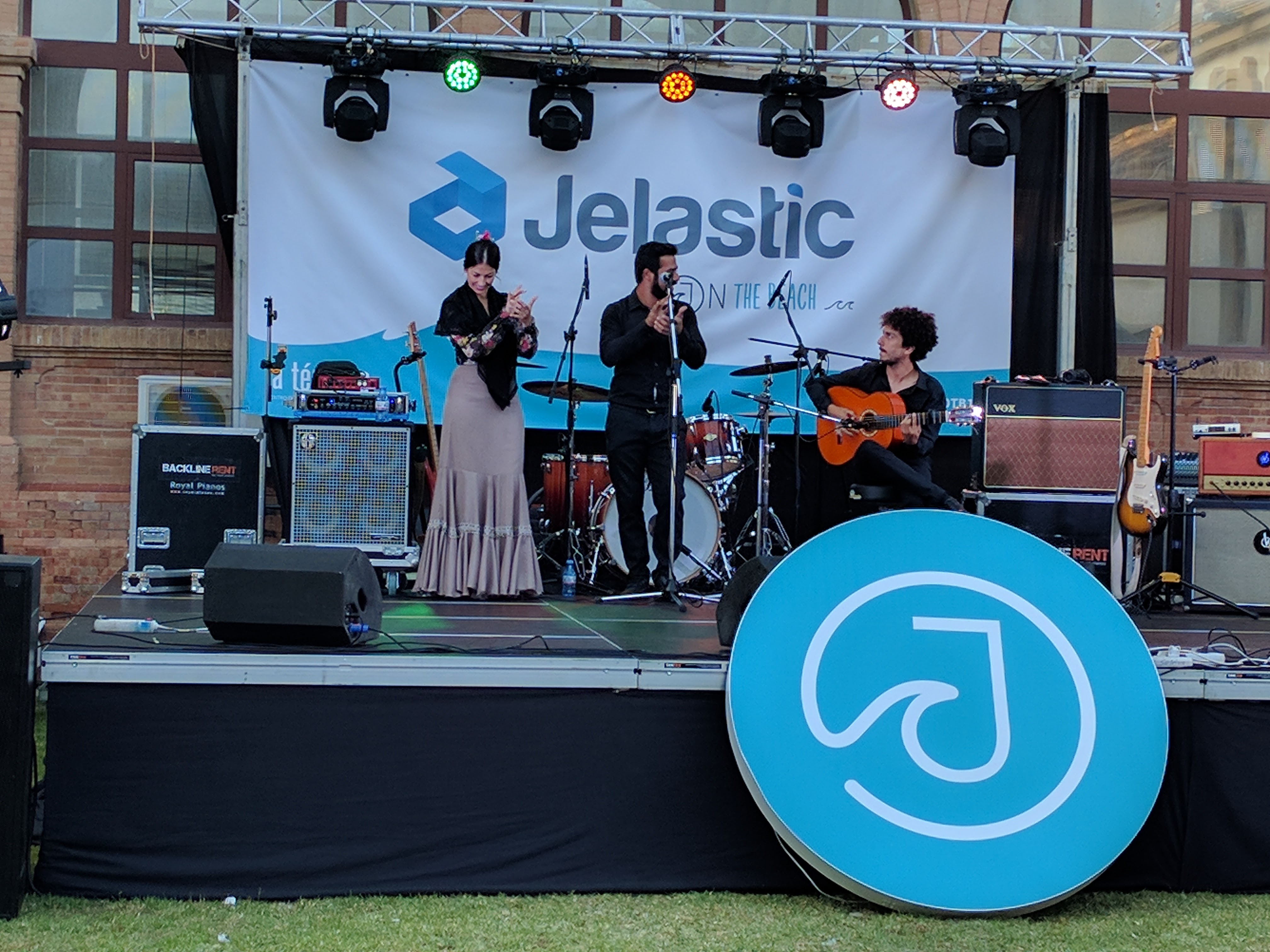August 8, 2017 — 30 minutes read
conference review

Panoramic view — Seaside of Malaga — Hiking the day after the conference
J On The Beach (JOTB) is “A Big Data Conference On The Beach” happening in Malaga (Spain) and this year (2017) was its second edition.
tl;dr
-
The staff was great, the speakers awesome and the talks interesting.
-
I felt very comfortable and almost at home during the three days. The atmosphere felt like being at a local conference but with famous and renowned speakers from around the world.
-
Everyone I met - speakers/attendees/staff - was accessible and affable.
-
I will detail the lunches and dinner in the rest of the article to make pauses between talks reviews and technical explanations, but it’s fair to say that the food was great and that the organizers made sure we wouldn’t forget our stay.
-
I came for distributed systems topics, and I’ve been served.
-
The party at the end of the event was fantastic, I’ve never seen so many geeks dance :astonished:
Preamble
I’ve discovered JOTB by accident in 2016, during the revelation of the
Panama Papers when I was searching for
technical details about how the ICIJ managed to
analyze this massive leak of data.
I stumbled-upon Mar Cabra’s
“The tech behind the bigger journalism leak in history”
, and after watching a few other talks I decided it was worth keeping an
eye on it for the next edition.
Soon enough, the 2017 line-up was released, followed by the schedule so when I saw the subjects and the speakers I managed to get one of the first round of tickets.
I didn’t know how to cut this article, maybe in half? or maybe an entry by
talk was more appropriate?
So I just kept everything in a single page and here is the table of contents
for you to hop around and read about the topics that you are interested in.
Table Of Contents
Overview
I’ll start by giving my experience of the conference just to try to make you feel what it was like to be there, I hope it’ll give context for reading my reviews of the talks.
-
The title of the conference “A Big Data Conference On The Beach” is not a scam: the beach is right there, 200 meters away from the conference venue La Termica.
-
The location was easy to find because it is a cultural center. It is not in the city center, more halfway between the airport and the center and can be reached in 40 minutes walk by the beach. There are hotels around and a bus stop 50m from the entrance, as well as city bikes spots.
-
The place in itself is nice, the hallways and rooms are large and bright.
-
The staff was really welcoming every days, everyone speaking English and willing to assist the speakers and attendees.
-
The registration process took forever on the first day but someone was available to guide me to my workshop room so I didn’t have to search (thank you!).
-
The necklace with printed program schedule and plan was a really great idea, but on the other hand the names of the attendees were not that legible. Also the bracelet that’s “your pass for the three days” that you can’t remove at night or to shower was annoying to me.
-
During the workshop and also during the talks, one could find several power strips along the chairs.
-
The conference WiFi was great during the two days of conference, but was really awful during the workshop and we even experienced an outage during 20 to 30 minutes (which is unfortunate when you’re
SSH-ing onto cluster nodes to run Jepsen tests). -
Breakfast, coffee/tea and milk was catered every morning and bottles of (cold) water were available all day long. There were also bottles of waters ready for each attendee in the workshop room which was a nice treat.
-
Speaking of treats, the swag bag was OK, but please bear in mind that I’m not much fan of goodies in general:
-
The t-shirt was cool, plus there were women sizes :raising_hand:
-
The aluminum water bottle was also a good idea
-
Only one sticker?
-
A frisbee, because it’s on the beach, you know :sunglasses:
-
-
The rest I can’t remember and didn’t bring back home… ¯\(ツ)/¯
Day1: Jepsen Workshop
I wrote about this workshop in a separate blog entry to save some space and not mix topics.
This other entry is just scratching the surface of what Jepsen is, what it does and how to does it.
I’m planning to write more about it in the future and I’ll make sure to put links here when it’s done.
Day 2: Talks
Eric Ladizinsky — Evolving Quantum Computers
This is the kind of opening that really stick with me.
If you don’t know about Quantum Computers,
D-Wave Systems or Eric Ladizinsky,
don’t feel bad, I didn’t know either (if you knew, good for you!).
So the conference started with a man going up on stage really naturally, presenting himself not as a programmer nor computer scientist but as a physicist.
He started talking about how, given our current tools and all computing power,
we are still unable to solve the real problems we are facing a civilization:
poverty, injustice, …others!
Which, put that way, is frankly quite depressing…
He took a step back and gave us his analyze on how, through evolution, our species (Homo genus) evolved step by step by first discovering, using and then mastering new tools (think :fire: , :tractor: , :factory: ), and how quantum physics might be another step forward.
He drew the parallel with computer science through our limited ability to find
the most advanced models for a task in data science: we manage to find good
results through the use of lots of training data and clever algorithms.
But when some algorithm can be successful by throwing more computing power at
them, some problem remain intractable.
Quantum computers leverage the principles of quantum physics
like entanglement
in order to evaluate all possible models and find the most efficient solution.
Eric gave us a great analogy with forgery: consider the molecules of metal
forming a sword.
The best sword ever can only be achieved by finding the best shape, the best
arrangement possible of its molecules.
So, of all the possible combinations, which one is the best?
Quantum physics can help us explore all the possible solutions, and find the most efficient models whereas classical computers would require centuries of computation.
Considering quantum computers like that really blew my mind. Of course realizing this kind of processors is hard and expansive, but they already exist!
D-Wave are making quantum computers, and each new evolution is faster than the previous one at a much higher rate than our current CPUs.
At the moment it seems like only the NASA and Google can afford to buy some of them and try them on, but we, as programmers, we can already program them with our current tools (Python, C++) thanks to cloud based environments and several layers of abstraction.
I’m short on words and my knowledge of quantum physics, quantum computers and the programming model to use them is limited, but if you are interested, here are some links:
Inés Sombra — The trouble with distribution
Inés Sombra is an engineer at Fastly and in this session she talked about tradeoffs in building a distributed system. And OMG she speaks really fast :race_car:
If I could summarize the entire talk in a single word, it would be “tradeoffs”.
Taking as an example the implementation of Faslty’s Image optimizer, Inés presented several stages of the evolution of the Image optimizer and the pros and cons of each solution.
To give a little bit of context and grossly describe this service, it is and
image processing and caching solution.
You give it the location of your original quality content images and a set
of Varnish Configuration Language rules, and each
time one of your clients requires an image it points to this high quality
image and gives query parameters about the expected size, ratio, quality, etc,
of the result it needs.
Then Fastly’s Image optimizer will search for a cached version of the image
result, optimize it on the fly in case of a cache miss, and eventually return
the expected result after caching it.
Of course a lots of details are missing but this is the big picture…
Throughout the talk, Inés weights the costs and benefits of:
- pre-processing all the catalog then caching VS on-the-fly transforming on a per-request basis then caching, or
- being centralized VS being distributed, or
- being consistent VS being available (or being “fast enough”), or
- stripping metadata VS keeping metadata, etc.
All in all, I think the talk had both too much and too little content. Let me explain:
It is true that Inés speaks really fast, but she still had to rush through
the last couple of slides in order to finish on time.
On the other hand, the talk was really high level on technical details and I
think that was the goal, but the tradeoffs slides with only pros and cons
about the “current” version of the service, with not a lot of details
about how this “current” version was designed made it difficult to really
realize what/how choices were made.
It’s worth re-watching and take time to rewind now that the video is available:
Kyle Kingsbury — Jepsen Talk
Once again, aphyr strikes with his presentation skills and humor.
To paraphrase him: “our databases are on fire”, and what we do as developers is try to hide this instability to our users through nicely designed and shiny APIs :rainbow:
But if we do our best for our users to continue riding around on unicorns all day long, we are sitting on top of systems of which we don’t really know the inner workings.
Since 2014, Kyle has been using Jepsen to test databases, queues and other distributed systems on the basis of what he suspected was wrong or what the README and documentation of those softwares were stating.
He found numerous “bugs” and “inconsistencies”, published them in a series of blog posts and worked with some of the teams to help analyze problems and improve stability.
What he shares with us is that we should test the software we use and
we depend on.
We should carefully read the claims and documentations of such systems,
but not take anything for granted, because all of these systems are developed
under physical and budget constraints, because formal testing is hard and
simulation testing is hard too.
Implementations of distributed systems might not be perfect, and some kinds of errors, loss or inconsistencies might be acceptable from a domain point of view, but that problem should not be hidden and assumptions must be validated.
More on Jepsen and simulation testing:
In the same series, I find this previous talk about Jepsen to be more informative for someone interested in learning about distributed systems, and it also might be the funniest talk I’ve ever watched: Jepsen II: Linearizable Boogaloo.
I’ve also came across this talk about simulation testing at FoundationDB. FoundationDB was a closed source “multi-model NoSQL database” that has been acquired by Apple since this talk.
Dharma Shukla — Lessons learnt from building a globally distributed database service from the ground up
For the first few seconds I was a bit bored by the tone of the presentation. Boy I was wrong!
During this talk, Dharma Shukla introduces us with CosmosDB, formerly known as DocumentDB.
Honestly, I didn’t even know this was a thing, and yet it is a really interesting product developed during the last 7 years by Microsoft: a schema-less, multi-model, globally distributed database in Azure Cloud :earth_africa:
There are articles that will better describe Cosmos DB than I could do, but what I will keep from Dharma’s talk is the amount of work the teams at Microsoft seem to have invested in ensuring strong and comprehensible SLAs for latency and availability, but also for consistency and throughput, which is another level of quality.
CosmosDB is fully schema agnostic and has its own way of structuring data so that you don’t have to worry about it (RDF under the hood?), and it also “indexes all the data”.
CosmosDB is multi-model in the sense that it supports document, graph of key-value data types and uses a SQL-like query dialect as well as MongoDB or graph APIs.
Another important feature of CosmosDB is it’s 5 different levels of consistency, from “strong consistency” to “eventual consistency”, Microsoft has implemented three other consistency models based on academic researches.
CosmosDB is available as a service on Microsoft Azure Cloud. There you can choose and elastically control with API calls the amount of storage and scale the throughput of your application and pay as you go down to a granularity of a second.
All those features are really impressive, they even brought Leslie Lamport (inventor of the Lamport clock and the Paxos consensus protocol among other things) on board and used it’s TLA+ formal language to design and verify for correctness. And they also use Jepsen…
I wasn’t expecting to be amazed by this talk but honestly if you’re not afraid of vendor lock-in or are already using Microsoft Azure, it looks amazing.
Lunch: Wraps+beers
The first day’s lunch consisted of wraps of different flavors, chicken, ham
or veggie :burrito:
They were good enough, and open beer bar was present just like the day before
so one just had to manage to eat and drink wisely in order to be fully ready
for the talks of the afternoon.
The lunch took place in the backyard just like on Wednesday, on the grass, under a beautiful sunny sky :sunny:
During the meal I reconnected with some of my fellow Jepsen workshop-ers to share our experiences about the morning talks:
- Andrei Dan and Sebastian Utz from CrateDB;
- Max Neunhöffer from ArangoDB;
- Sayat Satybaldiev from Zalando and
- Donnchadh Ó Donnabháin from Poppulo
Anjana Vakil — Custom Query Languages: Why? How?
In this talk, Anjana Vakil explains what is the difference between a DSL and a CQL and gives us some insights on how to design such languages with the goal of providing powerful abstractions while keeping usability in mind.
Roland Kuhn — Taming distribution: formal protocols for Akka Typed
I’m interested in actors but not familiar enough with Scala, Akka and the specific implementation that is presented here to provide a good review of this talk.
Christopher Meiklejohn — Just-Right Consistency: Closing The CAP Gap
Christopher Meiklejohn is a former software
developer in industry turned researcher after having worked at
Riak at Basho.
In this talk he talks about “Just-Right Consistency” or how to “exploit
availability whenever possible and only synchronize exactly when needed to
enforce application invariance".
Topics of the talk:
- Invariants
- CAP theorem
- AP and CP systems
- Consensus
- Causality
- Relative order
- Joint updates
- CRDT
- …
And this is me watching the talk:

What is this, I don't even.
This one gave me headaches, seriously. I’m not going to be able to summarize it in a short paragraph so I’ll go for the long one.
The state of cloud databases that has been for many years is that we traditionally put out data in databases in datacenter(s). We have clients from all over the world accessing a primary copy and we geo-replicate in order to ensure fault-tolerance and provide high-availability and low latency.
And in the event that one or more of the copy of the database cannot communicate with one another we have to make a choice, once and for all:
We either choose a Consistent-under-Partition (CP) or an Available-under-Partition (AP) approach.
Characteristics of a CP system:
- All the operations are synchronized (write or read) on order to “treat all the copies as one logical unit". A consensus protocol must be used in order to ensure a single system image across replicas.
- This is serializability (e.g., Google Cloud Spanner): provide strong consistency an minimize the amount of time you have to wait, but still slower than an AP system.
- Often over-conservative but very popular because easier to program! On the programmer side, the application is written without thinking about distribution: if I write something then I will read this something, this is a guarantee of linearizability.
Characteristics of an AP system:
- Operations are executed against local copies and then the result of those operations are then propagated asynchronously which may take time
- Reads and writes happen extremely fast, so we may have stale reads and write conflicts between two updates on two different copies of the database since they haven’t synchronized: they need to reconcile.
- The system can keep operating in the even of failure: Available but difficult to program.
Acknowledging the fact that there is no such thing as a “one-size-fits-all” consistency model for applications, Christopher presents us a better approach:
Express our application invariants (properties of the system that must always hold true), and provide a way for the system to automatically infer from the application and tailor the consistency choices (a.k.a. feature by feature) based on those invariants to guarantee that no violation occur, this is Just-Right Consistency.
Characteristics of Just-Right Consistency:
- Write sequential programs that enforce application level invariants and preserve this application behavior when deployed under concurrency and distribution.
- We will have AP compatible invariants: under an AP system we can guarantee these invariants without synchronization.
- And CAP-sensitive invariants: one way VS two ways communication
invariants:
- One way: an operation that may or may not happen atomically or in a particular order, but we don’t need a response so it works without synchronization
- Two way: two operations that are related or dependent will require coordination
- Provides tools for analysis and verification (e.g., at the IDE level): tell whether or not the application will be safe when it’s deployed, bringing the application code and the database closer together.
In the talk we follow the case study of a lifecycle management tool for prescriptions and drug delivery to demonstrate how some application invariants may be AP compatible while other being CAP-sensitive.
Our invariants will be:
- Relative order (referential integrity): Create a prescription record and reference it by a patient
- Joint updates (atomicity): Create prescription, then update doctor, then patient, then pharmacy
- Precondition check: Deliver medication only the intended number of times
The first two invariants are AP compatible, and the third one is CAP-sensitive as we shall see.
Characteristics of an AP compatible invariant:
- No synchronization: can operate locally without blocking. Its updates are applied locally and asynchronously propagated.
- Updates are fast and exploit concurrency.
- Updates must commute: non-commutative updates require CP.
What commutativity is:
Imagine we have two replicas of a register that are in agreement.
If two concurrent operations set different values (e.g., 2 and 3) for a
specific key on the two replicas and we don’t synchronize, we will have a
divergence.
Replication without coordination will not produce a single outcome, the system
cannot by itself decide which value should win unless being told so.
These two operations are said to be non-commutative.
Can we make non-commutative updates commutative? Yes:
- Using deterministic conflict resolution: pick a value that wins.
Use a timestamp-based algorithm (Cassandra’s Last Write Wins), or an application level merge/resolution (CouchDB, OrientDB, Aerospike, Riak). - using CRDTs: CRDTs are extended sequential data types that encapsulate (built-in) deterministic merge functions. I’m not very familiar so I will try to get into more details in future blog posts, but there are many different designs of CRTDs for different uses.
So what happens when we assume that the system we’re building has this property?
All operations will commute.
Let’s examine relative order and joint updates first.
Relative order invariant:
- We do something, then other actions, and ensure that the updates are seen in the proper order, this is relative order.
- If an operation P implies Q than the program makes sure that Q is written before P. As long as it’s in order on the target replica and that changes are replicated in the proper order, the invariant is never violated.
So we need a system that ensures causal consitency:
Updates that are causaly related to other updates (that influence other updates) that happen in an order should be delivered in the exact same order
Joint updates invariant:
- Given relative order, two replicas with updates are causally consistent, so far so good
- But still, inconsistent state of the database can be read by clients/replicas between updates
- Joint updates relate to atomicity: all-or-nothing
This is solved by grouping updates atomically in batches, taking snapshots along the way so clients (or other replicas) read consistent snapshots.
By ensuring these invariants on the database side based on the sequential program on the client side, at this point we are designing a system that has relative order plus joint updates, that is:
Transactional Causal Consistency: the strongest AP compatible consistency model.
Now for our last invariant: Preconditions check:
- Preventing getting the same prescription twice
- This is basically a counter with addition and subtraction operation
What happens when these operations happen concurently?
Addition for instance: Take a counter and apply an addition on a replica and another addition on a second replica. We assumed earlier that operations on our system will commute, so for instance adding 2 and then 3 is the same thing as adding 3 and then 2.
Addition is then stable under concurrency and we don’t have to synchronize.
Subtraction on the other hand is not stable under concurrency. If we decrement our counter on a replica and do the same thing on another replicat without synchronizing, we could break the invariant that the counter must always be greater than zero.
This is CAP-sensitive.
We have two solutions do deal with this issue:
- First: ¯\(ツ)/¯ We can be fine with this tradeoff and acknowledge that our invariant wasn’t really an invariant, e.g.: ensure that a pacient gets its prediction rather than being too conservative.
- Second: Forbid concurrency, a.k.a synchronization.
Wow, that was a long read!
This model is interesting because we can choose for each operation what consistency model suits best. And when I say “we”, I say the system. Because it’s hard to reason about these problems and we need new tools.
Need tools to analyse and allow or not operations to proceed by analysing where invariants could be violated and tell us where we’re fine and where we need synchronization.
This is a research topic with lots of movement.
Cristopher presents one model: the
CISE Analysis
(paper),
but I’m not going to go into
details at this point.
So we have AntidoteDB: Open-source, implemented in Erlang, built on top of Riak core, providing Transactional Causal Consistency and is in alpha release.
Antidote respects causality by program order through clients and provide an operations API as well as a transaction API.
A company is materializing around it and is in the process of raising money. The goal is to prodive the database open-source and for free and support and tools commercially.
Really interesting topic and talk, and lots of content!
Santiago Ortiz — Dynamic data visualization
Santiago Ortiz has a really interesting way of looking at things and explaining how he thinks data visualization is meant to become a more democratized way at analyzing data and not just something reserved to data scientists.
Referring to the memory palace technique for remembering complex numbers, he draw the following parallel:
Machines use numbers for encoding of information including stories.
And we need stories to store numbers.
The rest of the talk was a portfolio of data visualizations which was nice to see but not really informative unless it is your thing.
On the plus side, one of the examples Santiago gave was about a book :
[Rayuela](https://en.wikipedia.org/wiki/Hopscotch_(Cort%C3%A1zar_novel) by
Julio Cortázar.
This book, he explained, has been written in such a was that it can be read
linearly or in an unordered way following a pattern suggested by the author
to jump from chapter to chapter.
The visualization consisted in circles that allowed the viewer to screen
and read from a chapter to another.
Dinner
The dinner was served in the backyard once again. We had fresh our of the oven pizzas and beer as well as soft drinks.
I ate with other attendees and left shortly after so I missed the meetups that had been organized specially for the event.
Day 3: Talks
Duarte Nunes — ScyllaDB: NoSQL at Ludicrous Speed
I was interested in this talk because of its summary highlighting the work done on performance on ScyllaDB.
ScyllaDB is a distributed databased based on the same model as Cassandra: dynamo-based. Its characteristics are high write availability, eventual consistency and inability to do join queries.
ScyllaDB is fully compatible with Cassandra’s API and file format so you can drop replace it without a single code line change.
Where ScyllaDB delivers is on the performance aspects. According to the
benchmarks (we all love a good benchmark don’t we), a 3 nodes ScyllaDB
cluster is able to sustain the same load as a 30 nodes Cassandra cluster.
This is basically Cassandra on steroids
So how did the team manage to do that?
The answer is lots of time and efforts applying good algorithms and mechanical sympathy principles in order to squeeze every bit from CPUs and memory.
ScyllaDB uses a thread-per-core model to avoid context-switching between threads and allocates each core a private memory pool. So blocking calls are forbidden and ScyllaDB adopts an asynchronous programming style with futures and promises for networking and file I/O and use message passing between CPUs to hide latency from accessing memory.
On the memory side, ScyllaDB is very cautious about its memory space allocation and manages to compact memory to avoid fragmentation.
ScyllaDB also features an interesting and tunable self-monitoring tool (benchmarking itself) able to analyze the stress under which the database is and make decisions on which process to prioritize (queuing requests) and how to deal with background tasks such as compaction.
If you have a use case for Cassandra and are critical about your resources usage, I think it’s really worth taking a look at ScyllaDB which is also open source by the way.
Danielle Ashley — Uniting Church and State: FP and OO Together
When preparing my schedule, I selected this talk because it “talked about FP and OO together” and I really like the idea that a lot of OO problems could be solved by using more FP concepts and good practices. Or use OO techniques in order to gain performance in our FP code, for instance.
So I just completely ignored the first part of the talk and didn’t understand the “Church and State” pun until later, so yeah, I’m stupid.
After the conference I did my homework and looked at this church encoding thing and I realized it is really interesting as an exercise. At first, I didn’t see where it’d be useful unless you’re trying to implement a new language. But Danielle talked about the performance side of things, and it started to click.
Church encoding is a way of representing data and operators using nothing
more than recursion and anonymous functions. In this talk, Danielle is not
showing us how to implement
Church Numerals
but how, by thoroughly designing out programs, we can eventually make it
simpler to reason about (keep state in isolation),
invert the flow of control (push-pull FRP style instead of downstream
method calls) and improve performance (less object instantiation,
and avoiding Optional overhead in this example).
This will deserve another blog post in the future to explore this topic.
Justo Ruiz Ferrer — Adressing the elephant in the room: what a post-Hadoop era looks like
The title mislead to expect a talk giving insight about where the big data
processing techniques could go, but in the end for me it didn’t
deliver :elephant:
The talk was mainly just an explanation of the “my big data is bigger than
your big data” saying and a quick demo of Valo‘s streaming
platform.
The speaker (and CTO of the company hosting the event) is clearly comfortable
talking to an audience and fills the room with his speaking, and
I expected some insights or takeaway thoughts about the direction in which
our industry is going.
But I ended up with sort of a statement about our architectures moving from
batch processing to streaming processing, with the lambda
architecture, micro-batch processing and the dataflow model
which he didn’t mention.
No video available for this one.
Lunch: Paella!!!
The last day’s meal was an authentic Valencian Paella, and I can tell you they nailed it. It was fantastic.
Once again in the backyard under a sunny sky :sunny:
I’ve had the occasion to share with other conference attendees about the
previous talks and speak about programming languages and other geeky stuff.
Fun time :nerd:
Caitie McCaffrey — Distributed Sagas: A Protocol for Coordinating Microservices
Super interesting talk by Caitie McCaffrey about how to orchestrate multiple microservices in order to achieve consistency of a single business action.
Distributed Sagas is a protocol with no standard or open source implementation (yet) designed to create a layer of coordination on top of several (micro)services without having to write yet another service.
The example given in this talk is really simple and powerful: you have a
flight booking service to which was added a hotel booking service as well
as a car rental service, and you want to offer your customers the ability
to book an entire trip including those three services.
How do you ensure business/domain level consistency without creating a
new service?
This is not just an exercise: with the rise of microservices, we have moved
away from the consistency guarantees offered by our databases and must
maintain application-level consistency, or feral consistency.
And for each new service that is deployed and available we could
develop $n$ new combinations of coordination services in order to deliver new
value to customers…
Distributed Sagas introduces the concept of a SEC (Saga Execution Coordinator) along with action requests and compensating requests.
Based on a persistent log, the stateless SEC will come and write the
actions of other services and operations results to the log after
acknowledgement of the success of the action.
The SEC is then responsible to manage the consistency of the operations from
a domain perspective and replay or rollback operations in case of failure.
The log in this case is like a stack, where each operation performed by a service is idempotent (in order to be replayed in case of delay or timeout for instance) and has a corresponding backward idempotent action (compensating requests) that can be performed: a semantic undo.
Now this is interesting: because an action request from a service may be
delayed or just fail without returning (and we can’t make a difference), it is
important that it be idempotent in order to be replayed.
This way, we avoid the complexity of having to send a compensating request
to undo an action request that may or may not have succeeded.
By replaying, we make sure that we get a result and then we “cancel” if
need be.
For this protocol to be applicable, the business/domain model must be
compatible with eventual consistency because each service being exposed
individually exposes its state, and the whole saga cannot be made
isolated nor atomic under such constraints without introducing a lot
of latency and single point of failures (see the part of the talk about
two phase commit).
Indeed, the SEC itself might look like a SPOF, but it is actually
stateless so just spawning a new instance of it and replay the log is
sufficient to continue the saga :traffic_light:
From what I understood both Uber and Twitter are currently experimenting this technique, so we will have to wait and see what comes out.
Martin Thompson — High Performance Managed Languages
Famous for his work on high performance coding, Martin Thompson is a renowned expert and speaker.
At JOTB17, he gave us a talk about managed languages: languages that run on a virtual machine which provides garbage-collected memory management (Java, C#, etc.).
I’ve already listened to Martin in various podcasts and one thing that he mentions quite often is that:
Our CPUs Arent’t Getting Any Faster.
But most of our applications aren’t really CPU intensive, they are intensive
in their memory access.
Hardware constructors are adding cores in order to increase speed, and they
are doing wonders, but our little understanding of how CPUs and memory access
work prevents us from gaining all of the benefits.
Just like there was a debate between Assembler VS Compiled Languages, there’s an argument between managed languages VS native languages and this talk is just about that.
Managed languages benefit from JIT optimizations that a sole static
compiler cannot provide.
These are predictions made on real, measured data, and if it happens
that the bets are wrong, the JIT can correct itself, revoke some
decisions and make new optimizations.
Code branching
If a static compiler armed with a good programmer branch prediction hint/information can be a solid optimization, a managed language is able to use real data instead of static decisions and adjust over time.
Methods inlining
Methods/Functions can be inlined in case of hotness in order to avoid function call overhead.
Loop unrolling
The optimizer can also measure which loops are hotspots and which are not, and decide to unroll some rather than check and iterate.
Intrinsics
The runtime can also replace programmer instructions by architecture specific
instructions (intrinsics) in order to benefit from a the particular
implementation.
Something impossible for static compiler unless compiling for a specific
architecture.
Polymorphism
Managed runtimes can avoid virtual dispatch or going through jump tables
by directly calling the ‘right’ method of an object or inlining it.
By checking the number of subtypes we can decide whether or not it’s worth
to just calling the method directly, using a simple if statement,
go polymorphic or cache the code for a particular type if it is hotter
than the others.
Garbage Collector
The performance of a Garbage Collector depends upon its implementation, but also on how we, as programmers, deal with our objects.
Martin outlines the fact that it is not allocation that is costly, but
reclamation…
The longer and object lives, the more operations the GC needs to do.
In the end, THE most important thing to performance is TIME:
How much time and effort are we willing to put into implementing good algorithms and doing right choices™.
Some takeaways:
- Avoiding cache misses
- Amortising expensive operations
- Mechanical sympathy
- Algo & Data-structures
Fun facts:
Martin is the author of Aeron, a high throughput, low latency messaging system (it is used by Onyx, BTW).
The Java implementation of Aeron is faster than native implementation of other fast messaging systems: because of the time and efforts put into implementing good algorithms.
Aeron has been ported to C++, then Go, then C#: and in the end the fastest
implementation is in C#.
C++ could be but would take much, much more time
:hourglass_flowing_sand:
…
Dinner + Party
After dinner (Camperos :taco: + :beers: ), the organizers invited a flamenco dancer :dancer_tone1: , singer :microphone2: and guitarist :guitar: .
And after the local culture and art, the party started with a rock band doing cover songs as well as a group called Los Vinagres coming from the Canary Islands :island: .
I left with a few other attendees around midnight, going on a quest to find Tapas :fried_shrimp:
Conclusion
I think I’ve said it in the first part of the article but the conference
felt very comfortable and almost like a local conference, despite the
number of people from abroad and the awesome speakers.
It was then really easy to speak to people.
Thanks a lot to the organizers, speakers and other attendees for the great event.
And thanks a lot to MonkeyPatch (the company I work for) for paying and allowing me to attend a conference in Malaga!
On a side note, I’d like to apologize for the length of this article.
It took me way too long to write this review and if you made it thus far,
you’re a hero.
I really wanted to highlight the content of each talk and it took me researches
and learning to give it back.
I hope you enjoyed nonetheless. I don’t know if or how I will split my next
conference review because I’m still new in this field, but there will be more
content on most of the topics covered here in future blog posts.
Thanks for reading, see you :wave:

Leaving
Bonus track: The Computer Science behind a modern distributed data store
By Max Neunhöffer from ArangoDB.
I’ve talked multiple times with Max during the three days of the conference and didn’t even know he was a speaker until the last day.
I’ve watched his talk later on Youtube and I’ve found it really interesting to get a sense of some major problems one can experience while learning about or working on distributed systems.
It goes fast so if you are not familiar with distributed systems problems such as consensus, log structured merge trees, clocks and distributed ACID transactions you will find a lot of useful information in order to learn more about these topics.
This blog uses Hypothesis for public and private (group) comments.
You can annotate or highlight words or paragraphs directly by selecting the text!
If you want to leave a general comment or read what others have to say, please use the collapsible panel on the right of this page.









